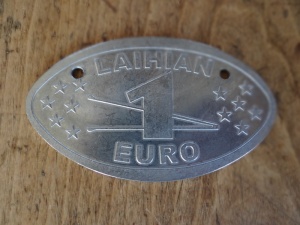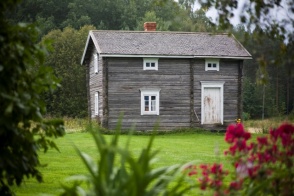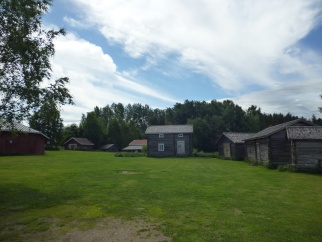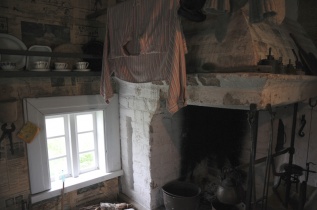Stinginess of the people in Laihia
| Stinginess of the people in Laihia | ||||
|---|---|---|---|---|
| In the national inventory | ||||
|
Practitioners and people who know the tradition well

Stinginess of the people of Laihia is well-known in Finland and in some places abroad. Laihia is well-known for its stinginess in the entire country, as documented by the decades old – and some more recent – jokes about Laihia and its people. Due to this, Laihia is also called the Scotland of Finland. People from Laihia are often seen as a symbol of stinginess and frugality, and a person who is very careful with their money may be said to be from Laihia. Thus, the idea is very well known. New jokes about the stinginess of the people from Laihia are invented constantly.
In 1997, Media People Oy carried out a survey about 40 different municipalities all over the country. People were asked what these municipalities/cities were known for. Answers from 299 different people were analysed. Over 84% of the participants were able to place Laihia correctly on a map including all the regions from Helsinki to Lapland, which was the best result in the whole survey. The best known aspects of Laihia, which over 80% of the participants were familiar with, were its stinginess, jokes about stinginess and people from Laihia, Laihian markka (a stretched coin), stretching pennies, being miserly, Finnish Scotland, being frugal and careful with money. Today, Laihia has about 8,100 inhabitants and they consider their stinginess a matter of pride. The stinginess of the people of Laihia has also been seen in a positive light: some companies even use Laihia in the names of projects that aim to save money for the company. Laihia also has a museum dedicated to exhibiting stinginess. Nuukuurenmuseo, the museum of stinginess, is located at the same property as the Laihian Kotiseutumuseo, the regional museum, and their operations are maintained by the regional association Laihian kotiseutu- ja museoyhdistys, which has been in operation for 80 years. Nuukuurenmuseo plays a significant role in upholding and promoting Laihia’s reputation as a stingy municipality. It is also the best-known attraction of Laihia.

Practising of the tradition
The tales, jokes and anecdotes related to Laihia’s stinginess are usually told when a person from Laihia and someone from elsewhere meet. Naturally, jokes about people from Laihia are well-known and often told outside the municipality, too, even if those telling and listening to them have no connections to Laihia. These jokes and tales can also be found in various joke books and humoristic online sites.
People not from the municipality will gladly take the opportunity to tell a joke about stinginess when they meet a person from Laihia. However, people from Laihia also like to tell such jokes. According to research carried out on the subject, the purpose of this tradition is probably maintaining a person’s own ethnic identity and the regional identity. Today, people from Laihia are proud of their reputation and the fact that their small municipality is well-known everywhere in Finland thanks to its reputation. By telling the jokes, people bring up the uniqueness of their municipality. It is great to know that the stinginess of people from Laihia is so famous and distinctive that this reputation has come about and the tradition of telling jokes was born. Telling a joke or an anecdote about the stinginess of people from Laihia is also a great ice-breaker in a conversation between a person from Laihia and someone from elsewhere.
At first, the stories told about the stinginess of people from Laihia were more mocking, which is why people from Laihia also had a negative attitude to their reputation. In a study carried out in 1998, the older generation in particular still regarded their reputation as stingy people as a negative thing. However, over the decades the jokes and tales have become more positive in tone. According to research on the subject, the attitude towards the people of Laihia’s reputation as stingy and the jokes told about them went through a particular change in the turn of the 1960s and 1970s. The people started to take advantage of their reputation, for example by publishing a book of jokes edited by the local Lions Club and coming up with other stinginess souvenirs.
Today, people from Laihia are so proud of their roots that they even want to teach being stingy to others, for example when they come to visit the museum dedicated to the subject. A few years back, the local Lions Club even had certificates printed: ‘Toristus nuukuuren opis olosta’, certification of having learnt stinginess, which were sold to the stinginess students as souvenirs.
The tone of the tales about the stinginess of people from Laihia is usually quite gentle and positive. Even in the jokes, the people from Laihia do not try to take advantage of others by tricking them, but instead they prefer to be cunning and very frugal. Perhaps Laihia was a green municipality long before the green movement. People from Laihia recycled long before the flea markets of Paris became trendy. After all, there is a proverb in Laihia that says ‘for others, stinginess is mandatory, for us, it is voluntary’. This means that even if a person from Laihia washes their disposable cup, it does not mean that they cannot afford to buy a new one. They drink coffee from a paper cup that has been washed a dozen times, because they can and because it saves paper cups. The idea behind this is to use and consume items, clothes and nature only to the extent that is necessary. Paying for any unnecessary status symbols is an outrage to a true Laihia local.
‘Nuukasti mutta komiasti’, stingily but greatly, is still Laihia’s motto today. The municipality’s coat-of-arms is also a nod to their stinginess; it features a frugal squirrel that stores food for rainy days. The municipality prefers to utilise the economic aspect of their stinginess reputation. The homepage of Laihia municipality says that ‘if stinginess means sensible actions, sustainable development and looking after residents’ interests – then we are stingy here in Laihia’. The reputation of stinginess is promoted and upheld by Nuukuurenmuseo, the museum dedicated to the theme of stinginess. Additionally, some companies in the municipality use the reputation for stinginess in their name and in marketing, for example: the consumers are told that it is economically advantageous to buy and/or use their services or that the customer can save by acquiring the products or services. Being from Laihia, i.e. being careful with money, has been referred to also by companies outside Laihia. For example, in 2015 there was a television advertisement for Scanoffice that advertised ‘a heat pump from Laihia’, a manually operated air pump that made its user sweat.

The background and history of the tradition
It is not certain how Laihia received its reputation as a stingy municipality. Most probably, the reputation dates back to the last years of Famine, 1856–1867. In 1866 or 1867, a large volcanic eruption occurred in Iceland, the ash of which darkened the sky for a long time. As a consequence, it snowed in Finland during Midsummer 1867. The harvest was destroyed, which led to the famine.
On 7 August 1854, Laihia municipal council had approved an act for managing poverty, i.e. an ordinance that was a great tool for managing affairs in the midst of the harsh famine years. The head of Laihia municipal council at the time was Frans Frederik and he realised that something had to be done to fight the hunger. The captain made it so that the poor people who were not landowners were placed on farms, where they were given two meals of gruel every day, and, in exchange for the meals, they worked on the farm according to their abilities. This kept the starving people alive and no one had to go begging. The farm owners were strongly against this arrangement, but the captain had been to military school and knew how to command and govern people. Beggars came and went, seeing the handsome Ostrobothnian farm houses. When the beggars asked for food at the houses, they were not given anything, they were just told that ‘we look after our own poor’. Diseases, especially typhoid fever, wiped out the hungry travellers. Many had to walk past Laihia without receiving one bite to eat. However, these measures prevented all the poor people of Laihia from dying, although dozens of others still died every week. Thus began Laihia’s reputation as a stingy municipality, spread by beggars from other parts of the country. Furthermore, after the famine, newspapers started publishing mocking articles about stinginess in Laihia. This can be considered the start of jokes and anecdotes about Laihia.
However, records about the frugal way of life in Laihia have been found from as early on as the 18th century. Stinginess has also been mentioned, but actual grounds for the reputation are difficult to find. It is possible that the reputation for stinginess started in the 18th century, after the Greater Wrath, the Russo-Swedish War and famine years. Laihia’s location along a road that led to a coastal city meant that many kinds of travellers wandered through the area, and it is possible that the people in Laihia became tired of constantly opening their doors to passers-by and were not always able to be courteous and generous to the travellers.
Marjatta Jauhiainen from the Finnish Literature Society (SKS) has researched the jokes about Laihia and thinks that the dialect could be the most probable reason for their reputation. In neighbouring municipalities, people have made fun of Laihia residents’ excessive use of the letter s: ‘Laihian skotti skiipes skorkooselle’, which simply meant that a boy from Laihia climbed on a bunkbed. However, in the Laihia dialect ‘skotti’ referred to a boy, while elsewhere it meant a Scotsman. Perhaps people outside Laihia made the connection to Scotsmen and thus to stinginess. According to Jauhiainen, some Laihia’s neighbouring municipalities, such as Vähäkyrö and Jalasjärvi, also once suffered from the reputation of being stingy. For some reason, these places did not inspire the jokesters as much.
In early 20th century, the folk poetry archives of the Finnish Literature Society (SKS) started to receive jokes and tales about Laihia in connection to other humour collection processes. In 1969, the Finnish Literature Society (SKS) and Lions Club Laihia organised a competition for collecting anecdotes about Laihia and its people. This was turned into a collection of Laihia humour with 1,006 different anecdotes. The collection’s name is Justhin piisas (Just enough). From the 1960s, the mostly local Laihia jokes became more wide-spread in the entire population and the short, pithy jokes were favoured over the longer anecdotes.

The transmission of the tradition
Nuukuurenmuseo, the stinginess museum maintained by Laihia’s regional and museum association (Laihian Kotiseutu- ja museoyhdistys) is an important body in promoting and maintaining the local reputation of stinginess. People can learn about stinginess through, for example, fun stinginess novelty items or items that have been worn and used through. The most famous novelty items is probably the stretched Laihia markka – today the Laihia euro – which was designed as a result of a competition held for school children. Regional Counsellor Esko Luoma has come up with a lively story for how the coin became so stretched: a farmer from Laihia and a Jewish clothier were tugging the coin to opposite directions, because one would have loved to sell, while the other hesitated to buy. Thus, the coin became oval in shape. Tourist guides have an important role in teaching visitors about Laihia’s reputation as a stingy municipality. At Nuukuurenmuseo, the guide tells visitors about stinginess and stinginess items, but also about the history of how the stinginess reputation came to be. The museum guide is often the only source to tell visitors from other regions or abroad about Laihia’s stinginess reputation.
Nuukuurenmuseo, the stinginess museum, is located in an small old cottage, and there visitors can learn about various items related to stinginess but also about the stories of the poor cabin residents, who only rented their cabin from the richer farmer and had no fields of their own to farm. The museum shows what life was like when one had to stretch the penny in all that they did. Regional Counsellor and the former president of Laihian Kotiseutu- ja museoyhdistys, Esko Luoma, worked hard for years in order to take advantage of Laihia’s stinginess reputation and establish Nuukuurenmuseo, the museum dedicated to the subject. Finally, this project was completed and the museum opened its doors to the public in 1992. The museum is located on the same property as Laihian Kotiseutumuseo, the regional museum, and is open during the summer.
The stinginess reputation is also used in other tourism marketing in Laihia, as well as in the marketing and advertisements of some companies from Laihia. In addition, Nuukuuren Viikko, a week dedicated to stinginess, is held in Laihia every year. Various events are arranged during the week, such as fitness classes, evening orienteering, cycling tours, fairy tale readings and other children’s activities, concerts, sing-alongs, flea markets, cemetery tours and other events. Furthermore, events such as Saiturin lenkki and Saiturin hiihto, ‘Miser’s run and Miser’s ski race’, respectively, have also been organised in Laihia. The construction of Laihia’s energy saving village in the 1980s also garnered interest in economic construction. Laihia has also chosen a ‘skitru’ (miser) of the year! In the 1990s, an impressive landmark for Laihia was planned along highway number three. However, the project did not come into fruition.
The famous reputation of Laihia is happily told to anyone travelling there if they are not already familiar with it. The stinginess and regional museums of Laihia have active Facebook and internet pages. Nuukuusnurkka, stinginess corner, on the website of Laihia municipality, features jokes, stories, poems and memories about Laihia as well as stinginess tips, etc. Additionally, jokes about Laihia and its people have been collected in several books, such as Ei makiaa mahan täyreltä, (Not too much of a good thing) and Justhin piisas kun kesken loppu (It was just enough when there was not quite enough). The topic of stinginess has even found its way into music: Nuukan likan jenkka, ‘the dance of a stingy lass’, was composed by Aleksi Riikonen and the lyrics were written by Veijo Pihjalamäki.
The future of the tradition
‘Laihia’s reputation as a den of stinginess is still going strong in speeches and talks, 150 years after the original events.’ This is an excerpt from an article by Iltasanomat about stinginess in Laihia on 23 February 2017. This indicates that the reputation for stinginess is still living oral tradition with numerous possibilities for utilisation. Energy saving, recycling and an ecological approach are examples of current trends that are a natural companion to stinginess and frugality. By utilising these, Laihia has the opportunity to, for example, arrange various events and seminars or partner projects, thus taking further advantage of their reputation. The role of Nuukuurenmuseo is vital not only to preserving the reputation of stinginess but also to passing on the history of this tradition. It carries out this duty by sharing the history both with museum guests and the followers of the museum’s Facebook pages. Social media, in general, is a great way to pass on this valuable tradition, especially to younger people.
The community/communities behind this submission.
Laihian Kotiseutu- ja museoyhdistys ry
Anne Riihimäki, Jaakko Heinimäki
Bibliography and links
Websites and videos
Laihia municipality Nuukuusnurkka
Blogikirjoitus: Lukijakertomus: Vintage kynttilänjalka kiteyttää kitsastelun idealogian.
YLE Elävä arkisto:Laihian ylpeät nuukat. Ajankohtaiskuvaus Laihiasta vuodelta 1973.
Mainosvideo: Laihialainen lämpöpumppu.
Youtube-video: Nuukan flikan jenkka
Litterature and other sources
Iltansanomat 23.2.2017: Legenda laihialaisten saituudesta syntyi suurista nälkävuosista, jotka tappoivat 150 000 suomalaista.
Haastattelut: Esko Luoma, Jaakko Heinimäki
Kaarto-Nurmeksela, Sari 1998. "Ei nuukuus oo kurjuutta. Se on hyvinvoinnin perusta." - Kansatieteellinen tutkimus nuukuudesta laihialaisuuden manifestoijana. Pro gradu -tutkielma, Kulttuurien tutkimuksen laitos, Turun yliopisto.
Laihian Kotiseutulehti 2016. Laihian Kotiseutu- ja museoyhdistys.
Rapila, Alpo K. Laihialaisten nuukuus : mistä asiasta on ollut kysymys ennen ja nyt
Rapila, Alpo K. Laihian suuri erikoisuus : säästäväisyys, nuukuus : mistä asiasta on ollut kysymys jo ennen ja on tänäkin päivänä
VASEK 2/2008, Vaasanseudun kehitys Oy:n tiedotuslehti.
Santeri Alkiosta (Ilkka-lehden ja Maalaisliiton perustaja) kertova wikiartikkeli
